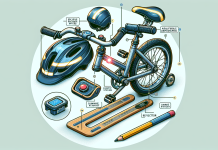When it comes to cycling, finding the perfect bike can make all the difference in your riding experience. That’s why we’re excited to introduce you to comfort bikes, a game-changer in the world of cycling. These bikes, designed with an ergonomic upright position, offer a solution to the age-old problem of back and neck strain. In this article, we’ll explore how comfort bikes prioritize your comfort and well-being, allowing you to enjoy the thrill of cycling without any discomfort or pain. Get ready to discover a whole new level of biking joy!
Table of Contents
Benefits of Comfort Bikes
Comfort bikes are a great option for individuals who prioritize comfort and ease of riding. These bikes are specifically designed to reduce strain on the back and neck, providing a more enjoyable and pain-free cycling experience. Let’s explore the various benefits of riding a comfort bike.
Reduced back and neck strain
One of the primary benefits of comfort bikes is the reduced strain they place on the back and neck. Traditional bikes often require riders to lean forward, putting significant pressure on the spine and lower back. In contrast, comfort bikes are designed with an upright riding position, which helps to alleviate this strain. By maintaining a more natural posture, comfort bike riders can avoid discomfort and prevent potential long-term issues.
Increased comfort
As the name suggests, comfort bikes are all about providing the most comfortable riding experience possible. These bikes feature a range of elements and features that prioritize rider comfort. From wide and padded seats to ergonomic handlebars, every aspect of a comfort bike is designed with the rider’s comfort in mind. By choosing a comfort bike, you can ensure a smoother and more enjoyable ride, even on longer journeys.
Improved visibility
Another advantage of comfort bikes is improved visibility. Due to their upright riding position, riders have a better view of the road ahead, making it easier to spot potential hazards and navigate through traffic. This increased visibility contributes to a safer cycling experience, reducing the risk of accidents and allowing riders to react quickly to any obstacles they may encounter on their journey.
Easier on the joints
Comfort bikes are also easier on the joints, making them an excellent choice for individuals with joint-related issues. The upright position on a comfort bike helps to distribute the rider’s weight more evenly, reducing strain on the joints, such as the knees and ankles. This feature is particularly beneficial for riders with arthritis or other joint conditions, allowing them to enjoy the benefits of cycling without exacerbating their pain or discomfort.
Upright Position and Back Strain
The upright riding position of comfort bikes plays a crucial role in reducing back strain and promoting overall comfort. Let’s explore how this position helps alleviate back pain and discomfort.
Importance of proper bike fit
To fully reap the benefits of the upright position on a comfort bike, it is essential to ensure proper bike fit. A bike that is too small or too large can lead to poor posture and increase the risk of back strain. Taking the time to find the right frame size and making necessary adjustments, such as saddle height and handlebar position, will ensure that your comfort bike fits you correctly and optimizes your riding experience.
Reduced pressure on the spine
The upright position of comfort bikes helps to reduce pressure on the spine by distributing the rider’s weight more evenly. Unlike a traditional bike that places a significant amount of weight on the lower back, the upright position encourages proper alignment of the spine. This alignment minimizes the compression of spinal discs and reduces the strain on the muscles in the lower back, reducing the likelihood of back pain.
Less strain on the lower back
The lower back is a common area of discomfort for many individuals, especially when riding a traditional bike that promotes a forward-leaning position. With comfort bikes’ upright position, the strain on the lower back is significantly reduced. Riders can enjoy a more relaxed riding experience, as the weight of the upper body is evenly distributed, relieving pressure on the lower back muscles and reducing the likelihood of strain or injury.
Upright Position and Neck Strain
In addition to the benefits for the back, the upright position of comfort bikes also helps reduce strain on the neck and shoulders. Let’s delve into how the upright position contributes to neck pain prevention and improved overall alignment.
Less strain on the neck and shoulders
The upright riding position of comfort bikes reduces strain on the neck and shoulders by allowing them to remain in a more natural and relaxed position. Traditional bikes often force riders to crane their necks upward or maintain a constant forward-bent position, leading to muscle tension and discomfort. Comfort bikes eliminate this strain, allowing riders to enjoy a more relaxed and pain-free ride.
Improved head and neck alignment
When riding a comfort bike, the head and neck are naturally positioned in alignment with the rest of the spine, rather than being tilted upwards or downwards. This alignment promotes proper posture and reduces the risk of developing neck pain or stiffness. By keeping the head and neck aligned, comfort bike riders can experience improved overall comfort and avoid the strain associated with poor alignment.
Reduced risk of muscle tension
The upright position of comfort bikes decreases the likelihood of muscle tension in the neck and shoulders. Traditional bikes often require riders to constantly engage and strain these muscles to maintain a forward-leaning position. In contrast, comfort bikes allow riders to relax their neck and shoulder muscles, reducing the risk of tension buildup and discomfort. By minimizing muscle tension, comfort bikes enable riders to enjoy a more relaxed and pain-free ride.
Comfort Bike Features
Comfort bikes are equipped with various features specifically designed to enhance rider comfort. Let’s explore some of the key features that make comfort bikes stand out.
Wide and padded seats
One of the most noticeable features of comfort bikes is their wide and padded seats. These seats provide ample support and cushioning, ensuring that riders can enjoy a comfortable seat even during long rides. The extra padding helps to absorb shock and reduces pressure points, which is particularly beneficial for individuals who are prone to hip or lower back pain.
Ergonomic handlebars
Comfort bikes are fitted with ergonomic handlebars that prioritize rider comfort. These handlebars are designed to allow riders to maintain a natural and relaxed grip, reducing strain on the wrists and hands. The ergonomic shape also promotes better control and maneuverability, enhancing the overall riding experience.
Front suspension
To further enhance rider comfort, many comfort bikes feature front suspension. This suspension system helps to absorb shocks and vibrations from uneven terrain, providing a smoother and more comfortable ride. Whether riding on paved roads or tackling off-road trails, front suspension ensures a less jarring experience, reducing the impact on the body and minimizing discomfort.
Shock-absorbing tires
In addition to front suspension, comfort bikes often come equipped with shock-absorbing tires. These tires are designed to cushion the ride by absorbing bumps and vibrations on the road or trail. By reducing the impact on the body, shock-absorbing tires help to minimize discomfort and provide a more enjoyable and pain-free cycling experience.
Choosing the Right Comfort Bike
Selecting the right comfort bike involves considering your personal riding needs and finding a model that fits you perfectly. Here are some essential factors to consider when choosing a comfort bike.
Consider your riding needs
Before purchasing a comfort bike, it is important to consider your riding needs. Are you planning to ride primarily on paved roads or do you intend to tackle off-road trails? Understanding how and where you will be riding will help you determine the specific features and specifications you should prioritize in a comfort bike.
Test riding different models
To find the ideal comfort bike for you, it is highly recommended to test ride several different models. This will allow you to experience firsthand how each bike feels and handles, helping you narrow down your choices. Pay attention to how the bike fits you, how it rides, and whether it provides the level of comfort and ease of use you desire.
Evaluating bike fit
Proper bike fit is essential to ensure optimal comfort and minimize the risk of strain or injury. When evaluating the fit of a comfort bike, pay attention to factors such as saddle height, handlebar reach, and overall frame size. A bike that is too small or too large can lead to discomfort and even long-term issues. Take the time to adjust the bike to your personal preferences and ensure that it aligns with your body’s proportions.
Adjusting the bike to your comfort
Once you have found the right comfort bike, it is important to make any necessary adjustments to further enhance your comfort. This may include adjusting the saddle height, handlebar position, or even replacing certain components to better suit your preferences. Taking the time to personalize the bike to your comfort will ensure a more enjoyable and pain-free riding experience.
Maintaining Proper Riding Technique
Maintaining proper riding technique is crucial to prevent back and neck strain when riding a comfort bike. Here are some tips to help you maintain the correct posture and riding form.
Maintaining an upright posture
When riding a comfort bike, it is important to maintain an upright posture to avoid unnecessary strain on the back and neck. Keep your back straight and your shoulders relaxed, allowing your spine to align naturally. Avoid hunching or leaning too far forward, as this can lead to discomfort and muscle tension. By consciously maintaining an upright posture, you can enjoy the full benefits of the comfort bike’s design.
Relaxing the upper body
Tension in the upper body can contribute to back and neck strain. To prevent this, consciously relax your upper body as you ride. Keep your arms and shoulders loose, and avoid clenching the handlebars tightly. By relaxing the muscles in your upper body, you can help reduce strain and ride in a more comfortable and pain-free manner.
Engaging core muscles
Engaging your core muscles while riding a comfort bike can help provide additional support and stability for your back. Focus on activating your abdominal muscles by pulling your navel towards your spine slightly. This engagement will help stabilize your torso and reduce the strain on your back. By maintaining a strong core, you can enhance your overall riding comfort and prevent unnecessary strain on your back and neck.
Stretching and Strengthening Exercises
Stretching and strengthening exercises can further enhance your comfort and reduce the risk of back and neck strain when riding a comfort bike. Incorporate the following exercises into your routine to improve your flexibility, strengthen your muscles, and alleviate any discomfort.
Stretching the back and neck muscles
Performing stretching exercises targeting the back and neck muscles is beneficial to prevent strain and improve flexibility. Start with gentle neck stretches, moving your head from side to side and up and down. Then, try a seated forward fold stretch, reaching towards your toes while keeping your back straight. Additional stretches like the cat-cow stretch or child’s pose can also help relieve tension in the back and neck.
Strengthening exercises for the core and upper body
To support your back and neck while riding, incorporating strengthening exercises into your routine is essential. Exercises such as planks, Russian twists, and seated rows can help strengthen the core and upper body muscles. Stronger muscles will provide better support and stability, preventing strain and reducing discomfort while riding a comfort bike.
Tips for Relieving Back and Neck Strain
Occasionally, even with the most comfortable bike and proper technique, you may still experience back or neck strain. Here are some tips to alleviate discomfort and relieve strain while riding your comfort bike.
Taking breaks during rides
If you start to feel any discomfort or strain in your back or neck during a ride, consider taking regular breaks to stretch and rest. Taking short breaks allows your muscles to relax and recover, reducing the likelihood of strain or stiffness. Remember to listen to your body and take breaks as needed to ensure a pain-free riding experience.
Using heat or ice therapy
Applying heat or cold therapy to the affected area can help alleviate back or neck strain. Heat therapy, such as using a heating pad or taking a warm shower, can help relax tense muscles. Cold therapy, on the other hand, can reduce inflammation and numb the area, providing pain relief. Experiment with both heat and cold therapy to find which works best for you in relieving discomfort from strain.
Seeking professional help
If back or neck strain persists or becomes severe, it is important to seek professional help. A qualified healthcare provider or physical therapist can assess your situation, provide a proper diagnosis, and offer specific treatments or exercises to address your specific needs. They can also provide guidance on maintaining proper posture and preventing further strain while riding your comfort bike.
Importance of Regular Bike Maintenance
Proper bike maintenance is essential to ensure the longevity and optimal performance of your comfort bike. Regular maintenance will not only enhance your riding experience but also contribute to minimizing strain on your back and neck. Here are some key aspects of maintaining your comfort bike.
Checking tire pressure and tread
Regularly checking the tire pressure and tread of your comfort bike is vital for a smooth and comfortable ride. Inadequate tire pressure can affect the bike’s stability and shock-absorbing capabilities, potentially leading to a less comfortable ride and increased strain on your body. Ensure that your tires are properly inflated and that the tread is in good condition to optimize safety and comfort.
Maintaining proper bike alignment
Misaligned bike components can significantly impact your riding experience and potentially lead to strain. Regularly check the alignment of your comfort bike, including the handlebars, saddle, and wheels. Any misalignment should be addressed promptly, either through personal adjustments or by seeking professional assistance. Proper bike alignment ensures that your body is positioned correctly, minimizing strain and discomfort while riding.
Keeping the bike clean and lubricated
Keeping your comfort bike clean and properly lubricated is important for maintaining smooth and efficient performance. Dirt and grime can accumulate on various components, increasing friction and making it harder for you to ride comfortably. Regularly clean your bike using a mild detergent and water, paying special attention to areas such as the chain, gears, and brakes. Additionally, lubricate moving parts with bike-specific lubricants to minimize friction and ensure smooth operation.
Conclusion
Comfort bikes provide numerous benefits, including reduced back and neck strain, increased comfort, improved visibility, and reduced strain on the joints. The upright position of these bikes promotes better alignment and distributes weight more evenly, minimizing discomfort and strain. By choosing the right comfort bike, maintaining proper riding technique, incorporating stretching and strengthening exercises, and implementing tips to alleviate back and neck strain, you can enjoy a comfortable and pain-free cycling experience. Remember to prioritize regular bike maintenance to ensure optimal performance and rider comfort. With the right approach, comfort bikes can offer a delightful and enjoyable riding experience for riders of all ages and abilities.





































